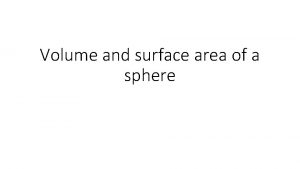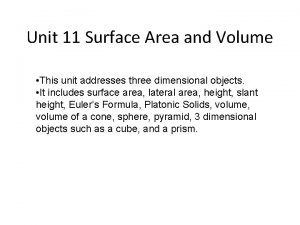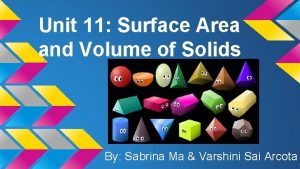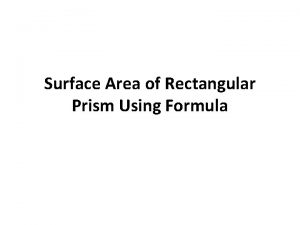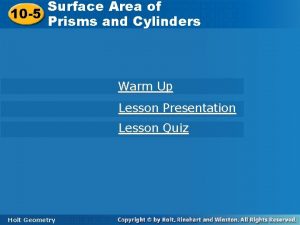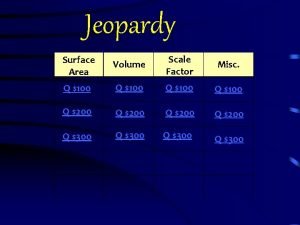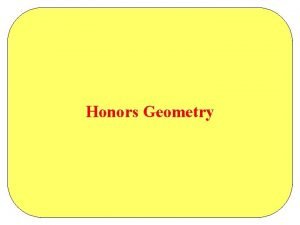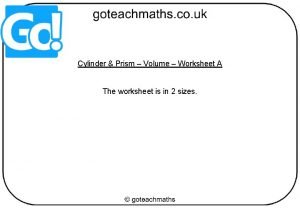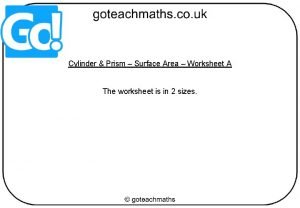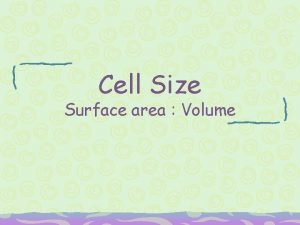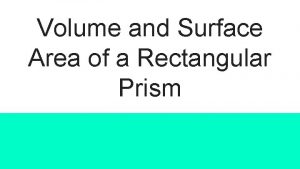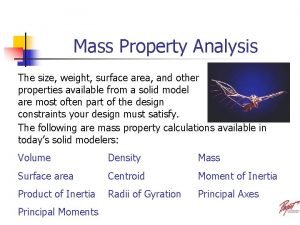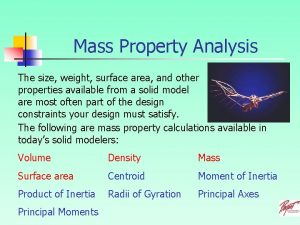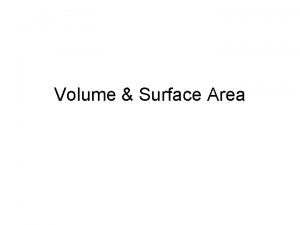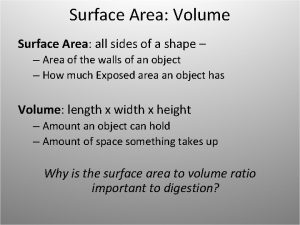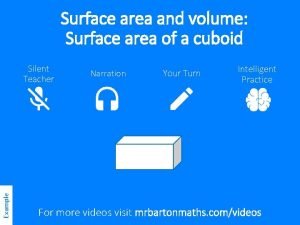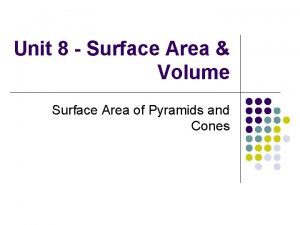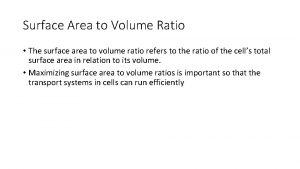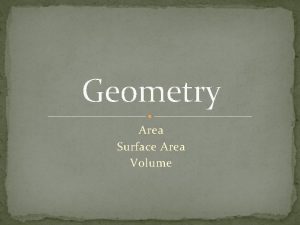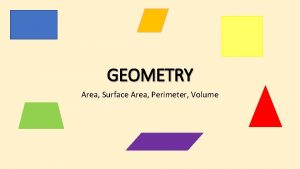Mass Property Analysis The size volume surface area























- Slides: 23

Mass Property Analysis The size, volume, surface area, and other properties available from a solid model are most often part of the design constraints your design must satisfy. The following are mass property calculations available in today’s solid modeling programs: Surface Area Centroid Volume Density Moment of Inertia Radii of Gyration Principal Axes Mass Product of Inertia Principal Moments

Mass Properties In this lesson, you will learn how to calculate the following mass properties: o o Surface Area Volume Density Mass

Area vs. Surface Area There is a distinction between area (A) and surface area (SA). Area describes the measure of the twodimensional space enclosed by a shape. Surface area is the sum of all the areas of the exposed faces of a three-dimensional solid.

Surface Area Calculations In order to calculate the surface area (SA) of a cube, the area (A) of any one of its faces must be known. The formula for calculating the surface area (SA) of a SA = 6 A cube is: SA = 6 x (4 in x 4 in) SA = 6 A SA = 96 in 2

Surface Area Calculations In order to calculate the surface area (SA) of a rectangular prism, the area (A) of the three different faces must be known. SA = 2(wd + wh + dh) SA = 2 x 44. 125 in 2 SA = 88. 25 in 2

Surface Area Calculations In order to calculate the surface area (SA) of a All Other Prisms, the area (A) of All faces must be known and added together or SA = 2 B +Ph can be used Where B = the Area of one Base, Base→(2 Parallel & Equal Faces) SA = 2 B + Ph P = The Perimeter of one Base, h = The Perpendicular Distance SA = 2(. 5 x 3 x 4)+(3+4+5)2. 5 in 2 between Bases SA = 30 in 2

Surface Area Calculations In order to calculate the surface area (SA) of a cylinder, the combined area of the circular faces and the area of the curved face must be known. The curved face is a rectangle with the Circumference of the circular face as its width & the height is the perpendicular distance between the circles. SA = 2( r 2) + (2 r)h SA = 2( r 2) +2( r)h SA = 14. 13 in 2 + 56. 52 in 2 SA = 88. 25 in 2

Surface Area Calculations o Hidden Faces on Left & Back Views In order to calculate the surface area (SA) of a Composite Figure, the area (A) of all exposed faces must be added together. Be sure to include faces that can’t be seen in the given view. Multiple Hidden Faces Underneath Since this shape is a Prism, the Front Face could be used as the Base and h could be used the Depth

Volume Calculations o o Volume is the amount of three-dimensional space contained within an object. Design engineers use volume to determine the amount of material needed to produce a part. Measure volume using cubic units: o o Cubic inches (in 3) Cubic feet (ft 3) Cubic yards (yds 3) Cubic centimeters (cm 3) Cubic meters (m 3)

Volume of a Cube A cube has sides (s) of equal length. The formula for calculating the volume (V) of a cube is: V= s 3 V= 3 s V= 4 in x 4 in V = 64 in 3

Volume of a Rectangular Prism A rectangular prism has at least one side that is different in length from the other two. Any Face can be used as the Base because All opposite faces are Parallel & Equal V= Bh The formula for calculating the volume (V) of a rectangular V= 4 in x 5. 25 in x 2. 5 in prism is: V = Bh V = 52. 5 in 3

Volume of a All Other Prisms The formula for calculating the volume (V) of a All prisms is the same: V = Bh The Difference is the Base (B) must be the shape that is not a rectangle. h is still the Perpendicular distance between the Bases V= Bh V= (. 5 x 3 x 4) x 2. 5 in V = 15 in 3

Volume of a Cylinder To calculate the volume of a cylinder, its radius (r) and height (h) must be known. The formula for calculating the volume (V) of a cylinder is: V = r 2 h V= 3. 14 x (1. 5 in)2 x 6 in V = 42. 39 in 3

Volume Calculations o In order to calculate the volume (V) of a Composite Figure, find the volume of familiar figures that don’t overlap and add them together. Since this shape is a Prism, the Front Face could be used as the Base and h could be used the Depth

Density o o Density is defined as mass per unit volume. Density is different for every material and can be found in a machinist handbook or will be provided for you.

Calculating Mass o o Mass is the amount of matter in an object or the quantity of the inertia of the object. Many materials are purchased by weight; to find weight, you need to know the mass. Mass = Volume x Density of Aluminum M = VD M = 36. 75 in 3 x. 098 lbs/in 3 M = 3. 6 lbs

Finding Mass Properties Using Inventor

Centroid o o o A 3 D point defining the geometric center of a solid. Do not confuse centroid with the center of gravity. The two only exist at the same 3 D point when the part has uniform geometry and density.

Moments of Inertia o o An object’s opposition to changing its motion about an axis. This property is most often used when calculating the deflection of beams. = Integral (Calculus) I = Moments of Inertia r = Distance of all points in an element from the axis p = Density of the material d. V= Division of the entire body into small volume units.

Products of Inertia o o Is similar to moments of inertia only that products of inertia are relative to two axes instead of one. You will notice an XY, YZ, or ZX after the I symbol when defining products of inertia compared to moments of inertia.

Radii of Gyration o A dimension from the axis where all mass is concentrated, and will produce the same moment of inertia. K = Radius of gyration about an axis M = Mass I = Moments of inertia

Principal Axes o The lines of intersection created from three mutually perpendicular planes, with the three planes’ point of intersection at the centroid of the part. The X, Y, and Z axes show the principal axes of the ellipsoid.

Principal Moments o Principal moments are the moments of inertia related to the principal axes of the part.
 Find lateral surface area of rectangular prism
Find lateral surface area of rectangular prism Surface area of a cone
Surface area of a cone 1260
1260 Radius of hemisphere
Radius of hemisphere Volume of composite figures
Volume of composite figures Unit 11 volume and surface area
Unit 11 volume and surface area Rectangular surface area
Rectangular surface area Lesson 10-4 surface area of prisms and cylinders
Lesson 10-4 surface area of prisms and cylinders Prism volume and surface area
Prism volume and surface area Volume and surface area of pyramid
Volume and surface area of pyramid Volume = 1/3 bh
Volume = 1/3 bh Volume maze
Volume maze Importance of surface area to volume ratio
Importance of surface area to volume ratio What is the name
What is the name Area perimeter volume jeopardy
Area perimeter volume jeopardy Volume and surface area jeopardy
Volume and surface area jeopardy Extending surface area and volume
Extending surface area and volume Volume of a cylinder and prism worksheet
Volume of a cylinder and prism worksheet Surface area of prism and cylinder worksheet
Surface area of prism and cylinder worksheet Cube and cuboid volume worksheet
Cube and cuboid volume worksheet Effects of changing dimensions on surface area and volume
Effects of changing dimensions on surface area and volume The ratio of surface area to volume limits
The ratio of surface area to volume limits Surface area to volume ratio
Surface area to volume ratio Rectangular prism template
Rectangular prism template



